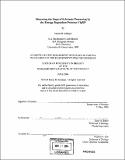Dissecting the steps of substrate processing by the energy-dependent protease ClpXP
Author(s)
Siddiqui, Samia M. (Siddiqui Mohammed), 1977-
DownloadFull printable version (5.147Mb)
Other Contributors
Massachusetts Institute of Technology. Dept. of Biology.
Advisor
Tania A. Baker.
Terms of use
Metadata
Show full item recordAbstract
Intracellular proteolysis is carried out by self-compartmentalized, energy dependent proteases which contain a regulatory and a proteolytic component. The regulatory component, which contains ATPases, has crucial activities necessary for the mechanism of degradation. To degrade a substrate the regulatory component recognizes and binds the substrate, then processes it further for degradation by actively unfolding and translocating it into a sequestered proteolytic compartment. The substrate is degraded into small fragments, approximately 9-11 amino acids long, that are then released. Both the regulatory and proteolytic components have pores which align to form a channel through which substrates are proposed to travel. In the bacterial energy-dependent protease ClpXP, ClpX is the regulatory component and ClpP is the proteolytic component. To better understand the proteolytic activity of ClpXP we investigated the steps involved in processing of substrates by ClpXP. The aim of this thesis is to present studies that have provided information about the roles of the important features of the ClpXP complex, namely the central pore of ClpX, the N-domain of ClpX and the channel of the ClpXP protease, during processing of substrates. Using mutational analysis I have found that the central pore of ClpX is involved in processing of C-motif 1 signals, one of the five classes of recognition signals, suggesting that ClpX processes its substrates with different recognition signals in at least two distinct manners. The central pore is also involved in engagement of C-motif 1 substrates, a step following binding but prior to further processing of substrates. (cont.) I have found that the N-domain is necessary for activity of the ClpX adaptor protein RssB in degradation of [sigma]. I have also found that the N-domain plays a differential role in degradation of ClpXP substrates, it is necessary for efficient degradation of protein substrates containing all of the recognition signals except C-motif 1. The N-domain was not necessary for degradation of N-motif 1 and N-motif 2 peptide substrates, which unlike protein substrates do not need to be unfolded during degradation. Thus suggesting that the N-domain is involved in steps following binding, that is, unfolding and/or translocation. I have shown that ClpXP can efficiently degrade proteins containing a disulfide-bond. This suggests that the ClpXP channel can expand to [approx.] 20-25A [Angstroms], since translocation of an intact disulfide bond requires simultaneous translocation of two, if not three, polypeptide chains. My work has contributed to understanding how ClpXP functions by providing insights into the roles of the central pore and the N-domain of ClpX in processing substrates and by demonstrating that the ClpXP channel can be flexible to accommodate its substrates.
Description
Thesis (Ph. D.)--Massachusetts Institute of Technology, Dept. of Biology, 2004. Includes bibliographical references.
Date issued
2004Department
Massachusetts Institute of Technology. Department of BiologyPublisher
Massachusetts Institute of Technology
Keywords
Biology.